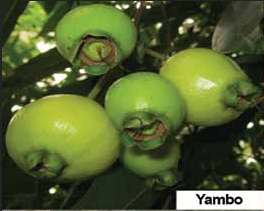In a world that is truly rich and diverse in natural resources, new discoveries and breakthroughs take place anytime and anywhere.

Segue to agriculture: man continues to discover various flora and fauna that can be used for food or serve other purposes. Older species are being rediscovered with their potential to feed the ever-growing consumer populace.
In the Philippines, the Department of Agriculture (DA) is now deep in the venture to make the country self-sufficient in food. One approach is through optimizing the production of staples that can supplement rice and through tapping the potentials of other relatively unknown but equally-valuable crops.
Before 2013 began, DA Secretary Proceso J. Alcala called on all Pinoys to support our farmers through buying and preparing various indigenous fruits that are healthy and delicious as they celebrate the hope of New Year. One of the indigenous fruits mentioned by the Secretary is the delectable rose apple, locally known as yambo.

Knowing the native yambo
Even though it is widely known as rose apple, yambo is not related at all to the apple fruit. Yambo (Syzygium jambos) belongs to the Myrtaceae family also known as the myrtle family, where other underutilized fruits such as binoloan, dayopod-mabolo, grumichama, eugenia fruits, guava, psidium fruits, jaboticaba, kamanla and tulanan belong.
Native to Southeast Asia, yambo was introduced to other regions, where it now bears new names like Malabar plum, plum rose, jambosier, water apple, pommarosa, and pomme rose.
The yambo fruit is round to oblong, resembling its close relative, guava. Its thin skin is pale yellow which may or may not have a faint, pinkish pigmentation. Inside, the yellowish flesh is uniquely crisp and doughy and has a sweet, mixed apple and watermelon taste with a rosy flavor which amplifies its rosy scent.
The center is a hollow cavity that contains one to four brown, slightly round and hard, rough-coated seeds. When the fruit is shaken, the seeds easily detach, leaving seed coat fragments affixed to the cavity wall.
The yambo tree is a small tropical evergreen that grows up to 7.5 to 12 meters tall. When mature, it has a thick canopy of wide-spreading branches and leathery leaves. What’s interesting is that the canopy’s width can exceed the tree’s height, which makes it a good shade provider.
Yambo thrives best in tropical to semi-tropical agro-climatic conditions on a loamy type of soil. It can also grow in other soil types such as sand and limestone.
The peak season of yambo is between June and September. Like some fruits, yambo is highly perishable and is easily bruised which is why it is not so popular in areas far from where yambo is grown. This characteristic limits the fruit’s marketability and its culinary, industrial, and medicinal potentials .
Beneficial uses and functions
In areas where yambo is grown, this fruit is popularly consumed as a fresh fruit dessert but it can also be processed into jam, jelly, stews and preserves. The yambo fruit contains protein, iron, fat, carbohydrates, calcium, calories, ash, magnesium, phosphorus, sodium, potassium, carotene, thiamine, riboflavin, niacin, ascorbic acid and fiber which make it a health food.
According to research conducted in other countries, yambo is said to be beneficial for the liver and brain as it boosts the vigor of these major organs. The fruit also has a diuretic function while the flower, when sweetened, has the ability to reduce fever. The leaf decoction can be used to relieve sore eyes and rheumatism.
Meanwhile, the seeds can aid in dysentery, catarrh (inflammation/irritation of the mucous membrane), diarrhea, and diabetes. However, it has been found that the seeds, roots, stems, leaves and bark contain certain levels of toxic elements, which then require that precautionary procedures be followed before these are further processed and utilized.
The essential oil found in the leaves can be distilled and the properties derived can be utilized in the industry of perfume. The brown to dark red heartwood can be used in crafting furniture, boat parts, light structures, packing cases and musical instruments. The yambo tree has flexible branches which can be weaved into baskets and casks.
Tapping the potentials of yambo
Many Filipinos, just like many people from all over the world, are only aware of the popular typical fruits that are produced in quantity in order to meet escalating demands for these commodities.
What we should know is that our country is a bountiful melting pot of various fruit crops, either introduced or native. Our generation and the following generations should know that there are other equally healthy and valuable fruit crops aside from mango, banana, pineapple, and ponkan, among others.
The Bureau of Agricultural Research (BAR), as the R&D arm of the DA, will look at the potentials of underutilized fruits like yambo that can thrive well in our lands and can potentially aid in the ultimate goal of “no more hungry Pinoy”.
———-
Sources:
1. Rose apple. www.fruitsinfo.com
2. Morton, J. Rose apple. www.hort.purdue.edu
3. Rose apple – A sacred tree of enlightenment from the land of Jambudvipa. www.toptropicals.com
4. Olchondra, R. T. Buy local fruits for New Year feast. www.newsinfo.inquirer.net
By: Leila Denisse Padilla BAR Digest October-December 2012 Issue (Vol. 14 No. 4)

Thanks for your marvelous posting! I quite enjoyed reading it, you may be a great author.
I will always bookmark your blog and definitely will come back from now on. I want to encourage you to
definitely continue your great writing,
have a nice afternoon!
where can i buy yambo seedlings?